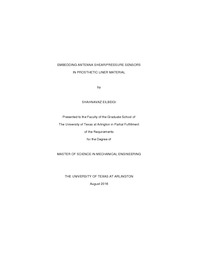
ATTENTION: The works hosted here are being migrated to a new repository that will consolidate resources, improve discoverability, and better show UTA's research impact on the global community. We will update authors as the migration progresses. Please see MavMatrix for more information.
Show simple item record
| dc.contributor.advisor | Huang, Haiying | |
| dc.creator | Eilbeigi, Shahanavaz | |
| dc.date.accessioned | 2017-09-12T15:04:03Z | |
| dc.date.available | 2017-09-12T15:04:03Z | |
| dc.date.created | 2016-08 | |
| dc.date.issued | 2016-08-26 | |
| dc.date.submitted | August 2016 | |
| dc.identifier.uri | http://hdl.handle.net/10106/26909 | |
| dc.description.abstract | Published surveys indicated that 40-60% of prosthesis users experience discomfort and skin problems. These studies highlighted the needs for enhanced prosthetic performance and fit. It is extremely difficult to address these problems due to two reasons: first, ambulation create varying areas of shear and pressure on the residual limb, but it is not clear which shear/pressure combinations are acceptable and what is the safe stress level for users. In addition, the volume of the residual limb changes throughout the day and activity level. Therefore, there is a strong need to develop a light, thin, flexible, and wirelessly interrogated sensor for an in-socket system that can measure the interface stresses at real-time. Our team presented a microstrip patch antenna sensor that is capable to measure the shear and normal deformations simultaneously. According to the principle of multi-layer microstrip patch antenna, the shear/pressure antenna sensor consists of a microstrip patch antenna and a U-shaped reflector separated by a layer of liner material. In this thesis, detailed investigations on the design of proposed sensor are presented and simulated using numerical simulation software. Different fabrication techniques are developed to fabricate the microstrip patch antenna and the reflector on thin flexible substrates, to integrate shear/pressure antenna sensor with commercial prosthetic liner, and to embed it in custom-made liners. The material selection criteria, the characterization of material properties, and the challenges facing the fabrication techniques are described in details. The radiation characteristics of fabricated sensors with/without liner were measured experimentally and compared with the simulation results to validate the sensor design. A method to design and fabricate antenna sensors with long transmission line also is presented and simulated. Finally, for characterizing the antenna sensors on an able-bodied volunteer, two different fabrication techniques are developed to embed two long antenna sensors in real-size custom-made prosthetic liner. In this thesis, some novel approach also are presented like: 1- Designed and validated complete fabric antenna sensor to improve the flexibility and compatibility; 2- Designed and validated the patch antenna with a meandering transmission line; which future work will provide the embedding and characterizing of such sensors in the custom-made prosthetic liner. | |
| dc.format.mimetype | application/pdf | |
| dc.language.iso | en_US | |
| dc.subject | Shear/pressure antenna sensor | |
| dc.subject | Prosthetic devices | |
| dc.subject | Fabrication techniques | |
| dc.title | EMBEDDING ANTENNA SHEAR/PRESSURE SENSORS IN PROSTHETIC LINER MATERIAL | |
| dc.type | Thesis | |
| dc.degree.department | Mechanical and Aerospace Engineering | |
| dc.degree.name | Master of Science in Mechanical Engineering | |
| dc.date.updated | 2017-09-12T15:05:07Z | |
| thesis.degree.department | Mechanical and Aerospace Engineering | |
| thesis.degree.grantor | The University of Texas at Arlington | |
| thesis.degree.level | Masters | |
| thesis.degree.name | Master of Science in Mechanical Engineering | |
| dc.type.material | text | |
Files in this item
- Name:
- EILBEIGI-THESIS-2016.pdf
- Size:
- 3.116Mb
- Format:
- PDF
This item appears in the following Collection(s)
Show simple item record


